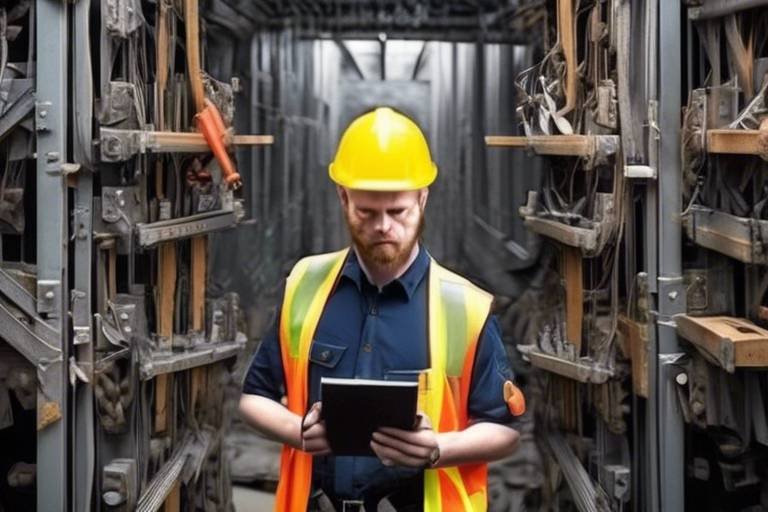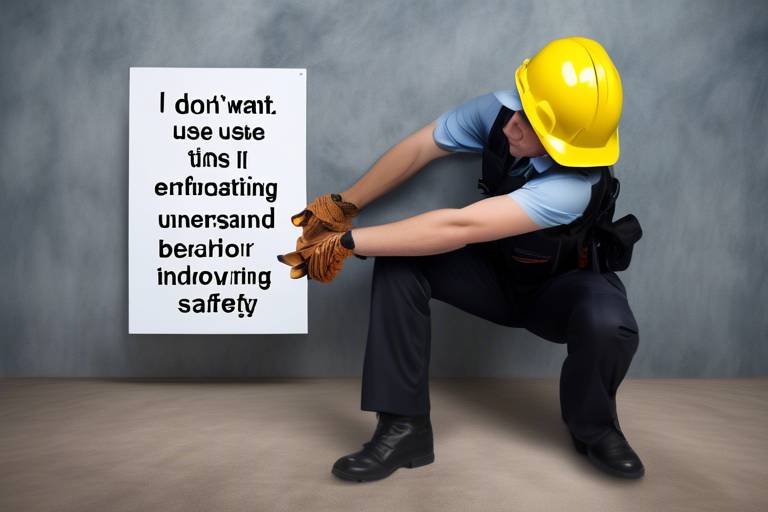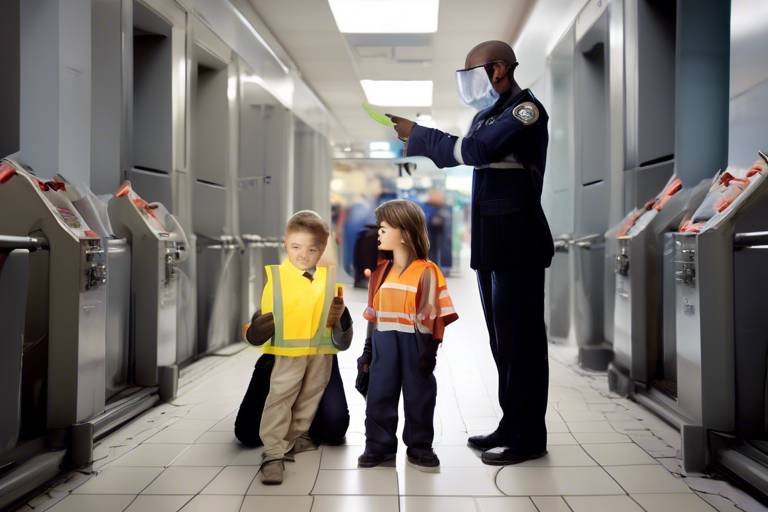Realizing the Power of Human Behavior: Reinforcing Safety Measures
In our fast-paced world, where safety can often feel like an afterthought, understanding human behavior is crucial for enhancing safety measures across all environments. Whether it's in the workplace, at home, or in public spaces, the way people think, feel, and act plays a significant role in how safety protocols are perceived and followed. Imagine a world where safety is not just a set of rules but a way of life, ingrained in the very fabric of our daily routines. This article explores how we can harness the power of human behavior to create a culture of safety that is proactive, engaging, and effective.
Understanding the psychological factors that influence safety behavior is not just interesting; it’s essential. Our perceptions, attitudes, and motivations shape how we respond to safety protocols and situations. For instance, if an employee believes that safety measures are merely bureaucratic red tape, they are less likely to adhere to them. On the other hand, when employees feel that their safety is genuinely valued, they are more likely to engage with safety protocols actively. This shift in mindset can be likened to changing the way we view exercise; if we see it as a chore, we’ll avoid it, but if we see it as a path to a healthier life, we embrace it.
Implementing effective behavioral safety programs can significantly reduce accidents and injuries. These programs focus on the behaviors that lead to unsafe conditions and aim to change them through various strategies. A successful behavioral safety program typically includes components such as training, engagement strategies, and feedback mechanisms. The impact of such programs on workplace safety culture can be profound, as they not only reduce incidents but also foster a sense of community and shared responsibility among employees.
Training employees on safety practices is vital for cultivating a safety-oriented mindset. Continuous education and hands-on training ensure that safety measures are not just theoretical but are practiced in real-life scenarios. Think of it like learning to ride a bike; no amount of reading can replace the experience of actually pedaling. Similarly, safety training should be interactive and engaging, allowing employees to practice and internalize safety protocols.
Engaging employees in safety discussions is crucial for encouraging ownership of safety practices. When employees feel they have a voice in safety matters, they are more likely to take responsibility for their own safety and that of their colleagues. Strategies for enhancing participation can include:
- Regular safety meetings where employees can share experiences and suggestions.
- Incentive programs that reward safe behavior.
- Creating safety committees that include employees from various levels of the organization.
These strategies not only increase engagement but also help build a community where safety is a shared value.
Establishing feedback mechanisms is essential for continuous improvement. Employees should have clear channels to voice concerns and suggestions regarding safety practices. This can be achieved through anonymous surveys, suggestion boxes, or regular one-on-one check-ins. By valuing employee input, organizations can adapt and enhance safety measures based on real-world experiences and insights.
Regular monitoring and evaluation of safety practices are essential for effectiveness. Organizations should assess the impact of safety measures on behavior and outcomes through methods such as:
- Incident reporting and analysis.
- Regular safety audits and inspections.
- Employee feedback on safety training sessions.
By continuously evaluating their safety practices, organizations can identify areas for improvement and ensure that safety remains a top priority.
Cultivating a safety culture within an organization requires commitment from all levels. It’s not just about having safety protocols in place but fostering an environment where safety is prioritized and valued. This involves not only the employees but also leadership and the community as a whole.
Leadership plays a pivotal role in shaping safety culture. Leaders must model safe behaviors and actively support initiatives that promote safety. When leaders demonstrate their commitment to safety, it sends a powerful message to employees that safety is not just a checkbox but a core value of the organization.
Involving the community in safety initiatives strengthens support and awareness. Community engagement can take many forms, from local safety workshops to collaborative safety campaigns. By working together, organizations and communities can reinforce safety measures and create a safer environment for everyone.
Q: Why is understanding human behavior important for safety measures?
A: Understanding human behavior helps organizations tailor safety protocols to be more effective, as it considers how employees perceive and react to safety measures.
Q: What are some effective engagement strategies for safety?
A: Effective engagement strategies include regular safety meetings, incentive programs for safe behavior, and the formation of safety committees that involve employees at all levels.
Q: How can feedback mechanisms improve safety practices?
A: Feedback mechanisms allow employees to voice their concerns and suggestions, leading to continuous improvement of safety measures based on real-world experiences.

The Psychology of Safety
Understanding the psychological factors that influence safety behavior is crucial in creating effective safety measures. Have you ever wondered why some people seem to disregard safety protocols while others strictly adhere to them? The answer often lies in their perceptions, attitudes, and motivations. These psychological elements shape how individuals respond to safety protocols and situations, making it essential to grasp their nuances to foster a safer environment.
At the heart of safety psychology is the concept of perception. How we perceive risks can dramatically affect our behavior. For instance, if an employee views a workplace hazard as a minor inconvenience, they may not take the necessary precautions. Conversely, if they recognize the potential consequences, they are more likely to engage in safe practices. This difference in perception can be influenced by personal experiences, cultural background, and even the information they receive about safety protocols.
Another vital aspect is attitude. An individual's attitude toward safety can often be shaped by their upbringing, workplace culture, and past experiences. For example, employees who have witnessed accidents or near-misses may develop a more cautious attitude, while those in environments that prioritize safety are likely to adopt a more proactive stance. In workplaces where safety is not emphasized, employees might feel that safety measures are unnecessary, leading to a culture of complacency.
Moreover, motivation plays a significant role in shaping safety behaviors. People are driven by various factors, including personal values, fear of consequences, and the desire for recognition. When organizations align safety practices with employees' intrinsic motivations—such as providing rewards for safe behavior or recognizing those who contribute to safety initiatives—they can foster a more engaged and safety-conscious workforce.
To illustrate this, consider the following factors that influence safety behavior:
- Personal Experience: Individuals with previous safety training or experiences are more likely to adhere to safety protocols.
- Social Influence: Peer behavior can significantly impact an individual's approach to safety; people often mimic the actions of those around them.
- Organizational Culture: A culture that emphasizes safety will encourage employees to prioritize it in their daily tasks.
In conclusion, understanding the psychology of safety is not just about recognizing risks; it's about addressing the underlying perceptions, attitudes, and motivations that drive human behavior. By focusing on these psychological factors, organizations can create tailored safety programs that resonate with employees, ultimately leading to a more robust culture of safety. So, how can we leverage this understanding to improve safety measures? The answer lies in proactive strategies that engage employees and foster a shared commitment to safety.

Behavioral Safety Programs
When it comes to workplace safety, are not just another box to check; they are a fundamental part of creating a safe environment. These programs focus on the human element of safety, recognizing that understanding and modifying behavior can lead to significant reductions in accidents and injuries. Imagine a world where every employee is not just aware of safety protocols but actively participates in them—this is the reality that effective behavioral safety programs strive to achieve.
At the core of these programs lies the principle that most accidents are a result of unsafe behaviors rather than unsafe conditions. By identifying and addressing these behaviors, organizations can create a culture where safety becomes second nature. This is where the magic happens: when employees feel empowered to take ownership of their safety and that of their colleagues. It transforms the workplace from a place of compliance to one of engagement and accountability.
So, what makes a behavioral safety program effective? It typically includes several key components:
- Observation and Feedback: Regularly observing employees as they perform their tasks allows safety personnel to identify unsafe behaviors and provide immediate feedback. This not only corrects unsafe actions but also reinforces safe practices.
- Training and Education: Continuous training ensures that employees are updated on the latest safety practices and understand the importance of adhering to them. This is crucial for fostering a safety-oriented mindset.
- Employee Involvement: Involving employees in safety discussions and decision-making processes encourages a sense of ownership. When people feel their voices are heard, they are more likely to commit to safety protocols.
Research has shown that organizations with robust behavioral safety programs experience fewer incidents and a stronger safety culture. For instance, a study revealed that companies implementing such programs saw a 30% reduction in workplace accidents within the first year. This statistic is not just a number; it represents lives saved and injuries prevented, which is invaluable.
Moreover, the success of these programs often hinges on effective leadership support. Leaders must not only endorse safety initiatives but also model safe behaviors themselves. When employees see their supervisors prioritizing safety, it sends a clear message that safety is a shared responsibility, not just a policy to follow.
In conclusion, behavioral safety programs are a powerful tool in the quest for a safer workplace. By focusing on human behavior, providing ongoing training, and fostering an environment of engagement and accountability, organizations can significantly enhance their safety measures. The journey to a safer workplace is ongoing, but with the right strategies in place, the destination is well within reach.
Q: What is a behavioral safety program?
A: A behavioral safety program is a systematic approach that focuses on identifying and modifying unsafe behaviors in the workplace to enhance safety and reduce accidents.
Q: How can I get my team involved in safety initiatives?
A: Involve your team in safety discussions, solicit their feedback, and encourage them to participate in safety training sessions. Recognizing their contributions can significantly boost engagement.
Q: What role does leadership play in these programs?
A: Leadership is crucial as they set the tone for safety culture. Leaders should model safe behaviors, actively participate in safety initiatives, and support their teams in prioritizing safety.

Training and Education
When it comes to fostering a culture of safety, are the cornerstones upon which everything else is built. Imagine safety as a sturdy house; without a solid foundation, the entire structure is at risk. In the workplace, this foundation is laid through comprehensive training programs that equip employees with the knowledge and skills they need to recognize hazards and respond appropriately. But it’s not just about the initial training; it’s about continuous education that keeps safety at the forefront of everyone’s mind.
Effective training goes beyond mere compliance; it engages employees and makes them feel empowered. Think of it like teaching someone to ride a bike. At first, they may wobble and struggle, but with practice and guidance, they gain confidence and skill. Similarly, regular safety training sessions help employees become adept at identifying risks and understanding safety protocols. These sessions should be interactive, incorporating real-life scenarios and hands-on practice. For instance, role-playing exercises can simulate emergency situations, allowing employees to practice their responses in a safe environment.
Moreover, the importance of tailored training programs cannot be overstated. Different roles within an organization may face unique safety challenges. For example, a construction worker will have very different safety training needs compared to an office worker. By customizing training to suit the specific risks associated with each job function, organizations can ensure that employees are not only informed but also prepared to handle the challenges they might face.
| Training Type | Description | Target Audience |
|---|---|---|
| Orientation Training | Introduction to safety protocols and company policies. | New Employees |
| Job-Specific Training | Focus on hazards specific to a particular role. | All Employees |
| Refresher Courses | Update on new safety practices and regulations. | All Employees |
| Emergency Response Training | Preparation for handling emergencies effectively. | Selected Employees |
But what about the ongoing commitment to safety? This is where continuous education shines. Safety isn’t a one-time event; it’s an ongoing journey. Regular workshops, safety drills, and refresher courses keep safety fresh in everyone’s mind. They serve as reminders that safety is not just a set of rules but a vital part of the organizational culture. Additionally, leveraging technology can enhance training efforts. Online modules, virtual reality simulations, and interactive e-learning platforms can make training more accessible and engaging, catering to various learning styles.
In conclusion, investing in is not merely a regulatory obligation; it’s a proactive strategy that pays dividends in the form of a safer workplace. By prioritizing comprehensive and continuous training, organizations can cultivate a workforce that is not only knowledgeable but also passionate about safety. This, in turn, leads to a culture where safety is valued and practiced by everyone, ultimately reducing accidents and fostering a positive work environment.
- Why is continuous training important for safety?
Continuous training keeps safety protocols fresh in employees' minds and equips them to handle new risks as they arise. - How can training be tailored to different roles?
By assessing the specific hazards associated with each job function, organizations can design targeted training programs that address those unique challenges. - What are some effective training methods?
Interactive methods like role-playing, simulations, and online modules can enhance engagement and retention of safety practices.

Engagement Strategies
Engaging employees in safety discussions is not just a checkbox activity; it’s a vital component of fostering a culture where safety is genuinely prioritized. When employees feel involved, they are more likely to take ownership of safety practices, leading to a more proactive approach to risk management. But how do we achieve this level of engagement? Let’s dive into some effective strategies that can make a real difference.
First and foremost, creating an open line of communication is essential. Employees should feel comfortable voicing their concerns and suggestions regarding safety practices. This can be accomplished through regular safety meetings where everyone is encouraged to share their thoughts. Imagine a roundtable discussion where every voice matters; this not only empowers employees but also creates a sense of community around safety. It’s like building a safety net, where each strand is a contribution from a team member.
Another effective strategy is to implement safety champions or ambassadors within the organization. These individuals can act as liaisons between management and employees, promoting safety initiatives and encouraging participation. Think of them as the cheerleaders of safety—enthusiastic, knowledgeable, and always ready to rally their teammates. This peer-led approach can significantly enhance the perception of safety protocols, making them more relatable and less bureaucratic.
Moreover, incorporating gamification into safety training can be a game changer. By turning safety practices into friendly competitions, organizations can motivate employees to participate actively. For example, you could run a safety challenge where teams earn points for identifying hazards or completing safety training modules. This not only makes learning fun but also reinforces the importance of safety in a memorable way. After all, who doesn’t love a little competition?
Lastly, recognizing and rewarding safe behavior is crucial. Acknowledging employees who consistently adhere to safety practices can inspire others to follow suit. Consider implementing a rewards program that highlights safe behaviors, such as a monthly recognition ceremony or a simple shout-out in team meetings. It’s like giving a gold star to those who shine in safety; it not only boosts morale but also reinforces the message that safety is a shared responsibility.
In summary, effective engagement strategies are about creating a culture where safety is everyone's business. By fostering open communication, empowering safety champions, gamifying training, and recognizing safe behaviors, organizations can cultivate a workplace where safety is not just a policy but a core value. Remember, when employees feel engaged and valued, they are more likely to contribute positively to the safety culture.
- What are engagement strategies in safety programs? Engagement strategies are methods used to involve employees in safety discussions and practices, ensuring they take ownership of safety measures.
- How can I encourage employees to participate in safety discussions? Create an open communication environment, hold regular safety meetings, and implement peer-led safety champions to promote involvement.
- What is gamification in safety training? Gamification involves incorporating game-like elements into safety training to make it more engaging and motivating for employees.
- Why is recognition important in safety culture? Recognizing safe behaviors encourages employees to adhere to safety practices and fosters a positive safety culture within the organization.

Feedback Mechanisms
Establishing within an organization is not just a good practice; it's a vital component of a thriving safety culture. Imagine a ship sailing the vast ocean without a compass or a captain's log. That’s what it’s like to operate without a feedback system. It’s all about creating a loop where employees feel empowered to voice their concerns and suggestions regarding safety practices. When people know their voices are heard, they’re more likely to engage actively in safety protocols, creating a ripple effect that enhances overall safety.
To effectively implement feedback mechanisms, organizations can use a variety of methods. For instance, regular safety meetings can serve as a platform for employees to share their experiences and suggestions. Additionally, anonymous surveys can help gather honest opinions without fear of repercussion. This is crucial because sometimes the most insightful feedback comes from those who might hesitate to speak up in a group setting. By fostering an environment where feedback is welcomed, organizations can identify potential hazards and improve safety measures before incidents occur.
Moreover, it’s essential to ensure that the feedback process is transparent. Employees should know how their feedback is being utilized and see tangible changes as a result. For example, if an employee suggests a modification to a safety protocol and that suggestion leads to an implemented change, acknowledging that contribution not only boosts morale but also encourages others to participate. It’s like planting seeds in a garden; with the right care and attention, those seeds can grow into a flourishing landscape of safety awareness.
In terms of structure, feedback mechanisms can be categorized into several types:
- Direct Feedback: This involves face-to-face discussions or one-on-one meetings where employees can express their thoughts directly to management.
- Surveys and Questionnaires: These tools can be distributed regularly to gather insights on safety practices and employee perceptions.
- Suggestion Boxes: Placing anonymous suggestion boxes around the workplace allows for spontaneous feedback.
- Safety Committees: Forming committees that include employees from various levels can facilitate ongoing dialogue about safety issues.
Ultimately, the goal of these feedback mechanisms is to create a continuous improvement cycle. When organizations actively seek and act on feedback, they not only enhance their safety protocols but also cultivate a culture where safety is a shared responsibility. Employees become more vigilant and proactive, knowing that their insights could lead to significant changes. It’s a win-win situation that fosters trust and collaboration across the organization.
Q1: Why are feedback mechanisms important in safety practices?
A1: Feedback mechanisms are crucial because they allow employees to voice their concerns and suggestions, leading to continuous improvement in safety protocols and a more engaged workforce.
Q2: What are some effective ways to gather feedback?
A2: Effective ways to gather feedback include direct discussions, anonymous surveys, suggestion boxes, and forming safety committees that encourage open dialogue.
Q3: How can organizations ensure that feedback is acted upon?
A3: Organizations can ensure that feedback is acted upon by being transparent about how suggestions are used and by acknowledging contributions that lead to improvements.

Monitoring and Evaluation
When it comes to ensuring safety in any environment, serve as the backbone of effective safety practices. Think of it as the compass that guides a ship through treacherous waters; without it, you could easily drift off course. Regularly assessing safety measures not only helps in identifying areas for improvement but also reinforces the importance of safety within the organization. So, how do we go about this? Well, it involves a systematic approach that includes both qualitative and quantitative methods.
First off, let’s talk about data collection. Gathering data on safety incidents, near misses, and employee feedback is essential. This information can be compiled into a comprehensive incident report that highlights trends over time. For instance, if you notice a spike in accidents during a particular shift, it might indicate that additional training or resources are needed. By analyzing this data, organizations can make informed decisions on how to enhance safety protocols.
Next, we can't overlook the significance of employee involvement in the monitoring process. When employees feel empowered to report unsafe conditions or practices, it creates a culture of transparency and accountability. Establishing a simple yet effective feedback mechanism—like an anonymous suggestion box—can encourage employees to voice their concerns without fear of repercussions. This not only makes them feel valued but also provides management with insights that might otherwise go unnoticed.
Furthermore, regular audits and inspections play a crucial role in evaluating safety practices. These should be conducted on a routine basis to ensure compliance with safety standards and regulations. Imagine a safety audit as a health check-up for your organization; just as you wouldn’t skip your annual physical, you shouldn’t overlook safety audits. During these inspections, it’s imperative to document findings meticulously and follow up with corrective actions to address any identified issues.
| Monitoring Method | Description | Frequency |
|---|---|---|
| Incident Reports | Documentation of all safety incidents and near misses. | Ongoing |
| Employee Surveys | Gathering feedback on safety perceptions and practices. | Quarterly |
| Safety Audits | Comprehensive evaluations of safety protocols and compliance. | Bi-Annually |
Lastly, continuous improvement should be the ultimate goal of monitoring and evaluation. Safety measures are not set in stone; they require ongoing refinement to adapt to new challenges and circumstances. By fostering a culture where feedback is not only welcomed but acted upon, organizations can create a dynamic safety environment that evolves with the needs of its workforce. Remember, a proactive approach to monitoring and evaluation can significantly reduce risks and enhance overall safety.
- Why is monitoring and evaluation important for safety? It helps identify trends, assess the effectiveness of safety measures, and fosters a culture of accountability.
- How often should safety audits be conducted? Ideally, safety audits should be performed bi-annually, but more frequent assessments may be necessary depending on the environment.
- What role do employees play in the monitoring process? Employees are crucial for reporting unsafe conditions and providing feedback, which helps improve safety protocols.

Creating a Safety Culture
Creating a robust safety culture within an organization is not just a task; it’s a journey that requires commitment and effort from everyone involved. Imagine your workplace as a garden; to flourish, it needs the right conditions, attention, and care. Just like plants need sunlight and water, a safety culture thrives on communication, accountability, and shared values. It’s about cultivating an environment where every individual feels responsible for not just their own safety but also the safety of their colleagues.
To kickstart this journey, it’s essential to establish clear safety values that resonate with everyone in the organization. These values should be visible and ingrained in the daily operations of the workplace. Think of them as the roots of your safety garden—deeply embedded and supporting everything that grows above. When employees understand the importance of these values, they become more likely to adopt safe behaviors as a part of their routine.
Moreover, fostering a safety culture is not a one-time event; it requires continuous engagement. Regular meetings and discussions about safety can keep the topic alive and at the forefront of employees' minds. For instance, consider implementing a monthly safety forum where team members can share experiences, discuss near misses, and brainstorm solutions. This not only enhances awareness but also promotes a sense of community and shared responsibility. When employees feel they have a voice, they are more likely to take ownership of safety practices.
Leadership plays a pivotal role in shaping this culture. Leaders must not only advocate for safety but also model safe behaviors themselves. When employees see their managers adhering to safety protocols, it reinforces the message that safety is a priority. It’s like watching a coach lead by example on the field; their actions inspire the team to follow suit. Leaders should also be approachable, creating an environment where employees feel comfortable reporting unsafe conditions or near misses without fear of retribution.
Another critical aspect of creating a safety culture is recognizing and celebrating safety achievements. Acknowledging team efforts can significantly boost morale and encourage ongoing commitment to safety practices. Whether it’s a shout-out in a meeting, a safety award, or even a simple thank-you note, these gestures can make a big difference. They remind everyone that safety is a collective effort and that every little action counts.
Lastly, incorporating community involvement can enhance your safety culture. Engaging with local organizations or safety programs can provide additional resources and support. For example, hosting community safety workshops or collaborating with local safety experts can bring fresh insights and foster a sense of shared purpose. When employees see that safety extends beyond the workplace, it reinforces the idea that safety is a lifestyle, not just a job requirement.
In summary, creating a safety culture is about more than just policies and procedures; it’s about nurturing an environment where safety is valued and prioritized. It requires the active participation of all levels of the organization, from leadership to front-line employees. By fostering open communication, modeling safe behaviors, recognizing achievements, and involving the community, organizations can cultivate a thriving safety culture that not only protects individuals but also enhances overall productivity and morale.
- What is a safety culture? A safety culture refers to the shared values, beliefs, and practices regarding safety within an organization. It's about creating an environment where safety is prioritized and everyone feels responsible.
- How can leadership influence safety culture? Leaders can influence safety culture by modeling safe behaviors, promoting open communication, and recognizing safety achievements, thereby setting a positive example for employees.
- Why is community involvement important in safety culture? Community involvement strengthens safety initiatives by providing additional resources, support, and fostering a sense of shared responsibility for safety beyond the workplace.

Leadership's Role
When it comes to fostering a culture of safety within an organization, leadership plays an absolutely pivotal role. Imagine a ship navigating through turbulent waters; the captain's decisions directly impact the crew's safety and the vessel's course. Similarly, leaders in any organization set the tone for safety practices and protocols. They are not just figureheads; they are the driving force behind the implementation and adherence to safety measures. Their actions, attitudes, and priorities can either cultivate a thriving safety culture or lead to negligence and complacency.
One of the most critical aspects of effective leadership in safety is modeling safe behaviors. When leaders prioritize safety in their daily routines, it sends a powerful message to employees that safety is non-negotiable. For instance, if a manager consistently wears personal protective equipment (PPE) and follows safety protocols, it reinforces the expectation that all employees should do the same. This kind of behavior creates a ripple effect, encouraging others to adopt similar practices. It’s like a chain reaction; one small act of commitment can lead to widespread adherence to safety measures across the organization.
Moreover, leaders must actively support safety initiatives. This means not only endorsing safety policies but also providing the necessary resources and training to ensure their success. For example, allocating budget for safety training programs or investing in advanced safety equipment demonstrates a leader's commitment to creating a safe workplace. In doing so, they empower employees to take ownership of their safety and the safety of their colleagues. This empowerment is crucial; when employees feel supported by their leaders, they are more likely to engage in safe practices and report unsafe conditions without fear of repercussions.
Communication is another essential tool in a leader's arsenal. Open lines of communication foster an environment where employees feel comfortable discussing safety concerns. Leaders should encourage feedback and be receptive to suggestions from their teams. Just as a gardener nurtures plants, leaders must cultivate a culture where safety discussions can bloom. Regular safety meetings, anonymous feedback channels, and open-door policies are effective ways to encourage dialogue around safety practices. By actively listening to their employees, leaders can identify potential hazards and areas for improvement, ultimately enhancing the overall safety culture.
To illustrate the impact of leadership on safety culture, consider the following table that outlines key leadership behaviors and their effects on workplace safety:
| Leadership Behavior | Effect on Safety Culture |
|---|---|
| Modeling Safe Practices | Encourages employees to adopt similar behaviors, creating a norm of safety. |
| Providing Resources | Empowers employees and ensures they have the tools needed to work safely. |
| Encouraging Open Communication | Fosters trust and allows for the identification of safety issues before they escalate. |
| Recognizing Safe Behavior | Reinforces positive actions and motivates others to follow suit. |
In conclusion, the role of leadership in promoting a culture of safety cannot be overstated. Leaders must not only talk the talk but also walk the walk. By actively engaging in safe practices, supporting safety initiatives, and fostering open communication, leaders can create an environment where safety is prioritized and valued. After all, a safe workplace is not just about compliance; it’s about cultivating a community where every individual feels responsible for their safety and the safety of others. So, let’s ask ourselves: Are we ready to lead by example in the quest for a safer workplace?
Frequently Asked Questions
- What is the most important role of leadership in workplace safety? Leadership is crucial in setting the tone for safety practices and ensuring that safety is prioritized throughout the organization.
- How can leaders effectively communicate safety protocols? Leaders can promote open communication through regular safety meetings, feedback channels, and by encouraging employees to voice their concerns.
- What impact does modeling safe behavior have? When leaders model safe behavior, it encourages employees to follow suit, creating a culture where safety is the norm.

Community Involvement
When it comes to reinforcing safety measures, is like the secret sauce that can elevate any initiative from good to great. Imagine a world where everyone—from local businesses to schools and even families—plays an active role in promoting safety. It's not just about following rules; it's about creating a culture where safety is a shared responsibility. By fostering a sense of community, we can transform safety from a mundane obligation into a vibrant, collective mission.
So, how do we get the community involved? First off, it’s essential to build relationships between organizations and community members. This can be achieved through various outreach programs that aim to educate and engage. For instance, hosting safety workshops or community forums allows individuals to voice their concerns and suggestions while learning about best practices. Additionally, local businesses can sponsor safety events, providing resources and support that encourage participation. When people see that their input is valued, they are more likely to take ownership of safety practices.
Another effective strategy is to create partnerships between organizations and community groups. These partnerships can lead to collaborative projects that address specific safety issues relevant to the community. For example, a neighborhood watch program can be established in collaboration with local law enforcement, focusing on crime prevention and emergency preparedness. This not only enhances safety but also strengthens community bonds, fostering a sense of unity and shared purpose.
Moreover, leveraging social media and local news outlets can amplify safety messages and initiatives. By sharing success stories and highlighting community efforts, we can inspire others to get involved. When people see their neighbors actively participating in safety initiatives, it creates a ripple effect that encourages more individuals to join in.
To make community involvement effective, it’s important to establish clear goals and measurable outcomes. This could involve tracking participation rates in safety programs or assessing the impact of community-led initiatives on local safety statistics. With a structured approach, communities can see tangible results, reinforcing the importance of their involvement.
In conclusion, community involvement is not just an add-on; it’s a vital component of any safety strategy. When individuals come together, share knowledge, and support one another, the collective impact can be profound. Safety becomes a community affair, and that’s when real change happens. Together, we can build a safer environment where everyone feels empowered to contribute to the well-being of their community.
- Why is community involvement important for safety measures? Community involvement ensures that safety practices are relevant, effective, and widely accepted. It fosters a culture of shared responsibility.
- How can I get involved in local safety initiatives? You can participate in community meetings, volunteer for local safety programs, or even start your own initiative to address specific concerns.
- What are some examples of successful community safety programs? Examples include neighborhood watch programs, community safety workshops, and collaborative emergency response training.
Frequently Asked Questions
- What is the importance of understanding human behavior in safety measures?
Understanding human behavior is crucial because it helps identify how people perceive risks and respond to safety protocols. By recognizing psychological factors such as attitudes and motivations, organizations can tailor their safety measures to be more effective and relatable.
- How do behavioral safety programs work?
Behavioral safety programs focus on changing employees' behaviors and attitudes towards safety. They involve training, continuous education, and practical engagement strategies that encourage individuals to take ownership of their safety and that of their colleagues, ultimately leading to a safer workplace.
- What role does training play in promoting safety?
Training is essential as it equips employees with the knowledge and skills needed to recognize hazards and respond appropriately. Continuous education and hands-on training foster a safety-oriented mindset, making employees more vigilant and proactive in their safety practices.
- How can feedback mechanisms improve safety practices?
Feedback mechanisms provide a platform for employees to voice their concerns and suggestions regarding safety practices. This open communication encourages a culture of continuous improvement, helping organizations adapt and enhance their safety measures based on real-world experiences and insights.
- What steps can leadership take to cultivate a safety culture?
Leadership can cultivate a safety culture by modeling safe behaviors, actively participating in safety initiatives, and promoting open communication. By demonstrating a commitment to safety, leaders inspire employees to prioritize safety as a fundamental value within the organization.
- How does community involvement enhance safety measures?
Community involvement strengthens safety measures by fostering awareness and support. Engaging community members in safety initiatives creates a collective responsibility for safety, making it a shared priority that extends beyond the workplace and into the broader community.



















